LOVE and STILTGRASS
“Indefatigable.” That’s the adjective that best describes the many exceptional individuals leading invasive plant removals in our local parks and other natural areas. Sure, I’ve previously pitched in on their efforts, helping to remove English ivy, garlic mustard, mile-a-minute weed and other harmful plants—but I’d never considered joining those unsung heroes’ impressive ranks. Restoration leaders work hard. They schedule regular invasive management days for weekends, coordinate and wrangle volunteers, and take on a lot of lonely solo work. Their task is a daunting and unending enterprise. And it’s completely unglamorous to boot.
But there I found myself this past summer in Reston’s Lake Fairfax Park, a newly certified Invasive Management Area (IMA) program lead, toiling in the Northern Hemisphere’s toastiest summer on record: bending, squatting, sweating, and endlessly repeating.

(Photo courtesy D. Tyler Long)
How did I get here?
When I was first introduced to this wooded area of the park, it was late March. I was there with the Mid-Atlantic Off Road Enthusiasts (MORE) to start construction on a multi-use trail that would be a memorial for my husband, Marc: the “Marc Genberg Trail.”
Marc was an avid cyclist and active member of MORE and had volunteered in Lake Fairfax Park on the morning of the day he suddenly died. He was just 52. MORE was instrumental in securing approval for Marc’s memorial from the Fairfax County Park Authority and had spent a good deal of time advocating. They knew Marc well and knew that the trail would be an exceptional and enduring honor for an extraordinary man. Naturally, I didn’t want to miss a single day of its construction.
That first early spring Saturday, and the next four, were coordinated by MORE trail leads, Frank Raiti and Tony Watkins. They were the driving force and inspiration for the impressive number of volunteers who turned out: men and women of varying ages, teenagers and children, MORE cycling members and other trail users. These folks all possessed gung-ho attitudes and radiated with warm smiles—and most hadn’t had the fortune to meet Marc.
Friends of mine and Marc’s friends also stopped by to help. And on one of the days, Marc’s 85-year-old dad, Dick, eagerly drove down from Pennsylvania to work side by side with men less than half his age. The entire effort was amazing.
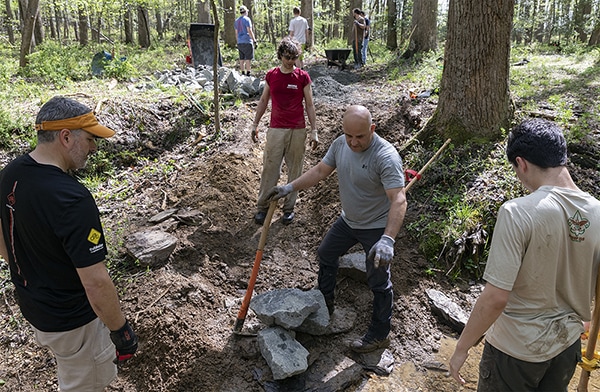
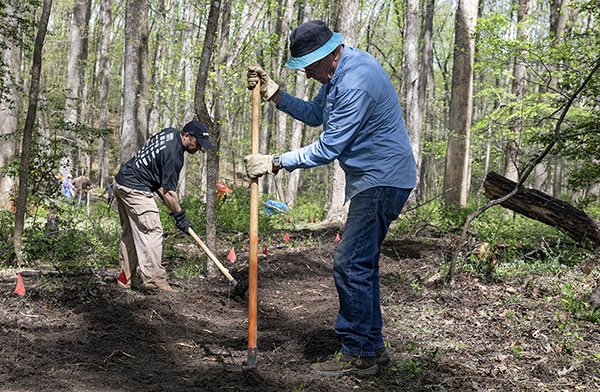
The new section of singletrack trail wound its way through a designated wildlife sanctuary and connected at either end to other existing trails. It cut under a canopy of mature oaks and tulip trees and around evergreen American holly, Christmas fern and partridge-berry—and other plants that were, for the moment, leafless. Beautiful and peaceful, this setting resonated wildly because Marc and I had often explored similar territory together. We roamed many Virginia trails and untold miles over 17 years, and hiking was hands-down our favorite activity. On one of our early outings, Marc, ever the naturalist at heart, had taught me to identify my first locally native tree—the American beech—and he was vocal about planting oak trees long before it became Doug Tallamy’s call to action.
After five rain-free days filled with digging, raking, shoveling, gravel-slinging and plant-relocating, the meandering one-third mile woodland trail was completed. It was one of the best sections in the park, I was later told by Marc’s cycling friends, with a grueling uphill climb that Marc would’ve enjoyed powering through.
MORE held an intimate informal dedication on May 4th, led by their president, Ernie Rodriguez. Then, at a public ceremony on June 1st, on National Volunteer Day, the Fairfax County Park Authority officially dedicated the “Marc Genberg Trail.” Supervisor Cathy Hudgins, Park Authority Deputy Director Sara Baldwin and Park Authority Board Bill Bouie imparted kind words about Marc and his years of volunteerism.
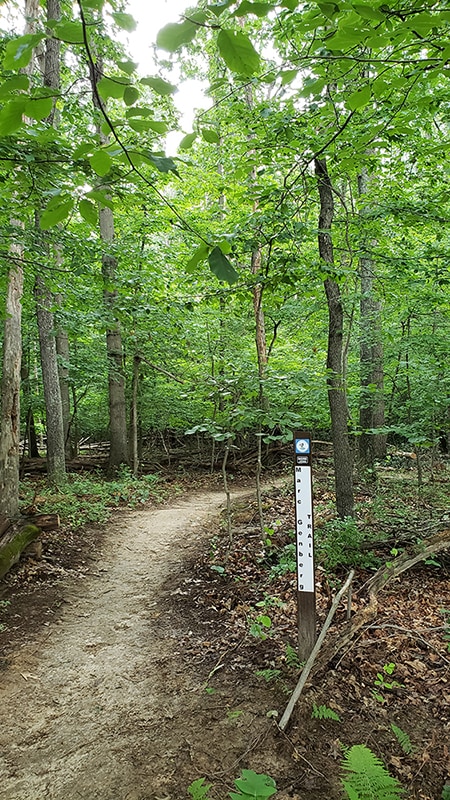
Surprise, Surprise.
During those spring trail-making days, there wasn’t much green unfurling just yet. The deciduous plants that were most conspicuous were the invasive Japanese barberry shrubs that dotted the landscape. Wouldn’t this be a relatively easy area to maintain? I thought early on. I decided I would obtain my IMA certification so I could officially remove the invasive plants surrounding Marc’s trail. I would want to visit frequently anyway.
However, time moved forward, and plants quietly grew. By the time May rolled around, what was formerly a latent beige-colored understory was now a vibrant green. And I knew exactly what that sort of growth indicated. Yes, I was duped! It was the hateful Japanese stiltgrass, out in full force. And I had already committed to Fairfax County. The reliably truthful words “no good deed goes unpunished” popped into my head and made me grin. It was a phrase Marc was fond of saying.
I did my homework and read up on Japanese stiltgrass, and I also asked the Arlington Regional Master Naturalists for suggestions. The outlook was not particularly positive but could’ve been interpreted as hopeful, in a masochistic kind of way. Their collective advice: “Just keep on pulling.”
So, pull I did.
The effort to remove Microstegium vimineum has been called a Sisyphean task by a few knowing naturalist friends. Sisyphus, for the similarly uncultured, was a mythological Greek figure who was condemned to an eternity of frustrating labor: rolling a boulder up a hill only to watch it roll down again. A perfect analogy, I thought—once I looked it up.


Healing the Land, Easing a Heart
Once a week throughout the steamy summer, I attacked not only stiltgrass, but also Japanese honeysuckle, oriental bittersweet, small barberry plants and patches of wavyleaf basketgrass. The stiltgrass, low in stature and crazily abundant, was naturally the worst of it. Hand-pulling it from in and around the various ferns, sedges, hog-peanut, poison ivy and other native plants was a tedious chore. So this is what it’s like to weed a forest? I wondered.
But those long stretches of labor tended to be tolerable, even as sweat continually streamed into my eyes and the humidity fogged my glasses. On occasion, I’d be greeted by Marc’s teammates from The Bike Lane, who were out on a joyful ride. Sometimes a curious passerby would stop to inquire about my efforts. And many times I’d be given the opportunity to educate the dog walker who moved through the area with their pet running off-leash.
What I came to appreciate was the quiet and solitude on weekdays, since Marc’s trail was seldom frequented then. It was a time of reflection, of thoughts that could be painful; a longing indescribable. Marc should be here.
Often, a pileated woodpecker’s hollow drumming would interrupt the silence—and a few times I heard the piercing call of a hawk. And there was this one memorable encounter: while I knelt under a very tall tulip tree, I heard a sudden “plop!” What fell from high, high above was large, chubby and brilliantly green: a tulip tree silkmoth caterpillar. Hey my plump friend. Perhaps you’re also moving towards your next stage of life?
Frequently, I came upon other interesting insects, as well as frogs, toads, turtles, and two different snake species. Arthropods that I’d never seen in the wild before, such as a northern walking stick and a marbled orb weaver, completely delighted and relieved the monotony.
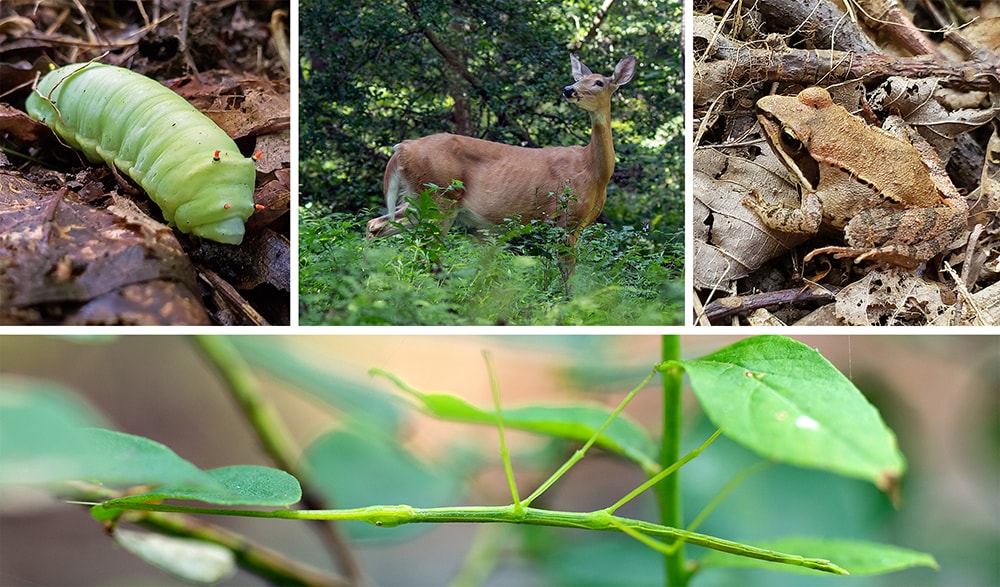
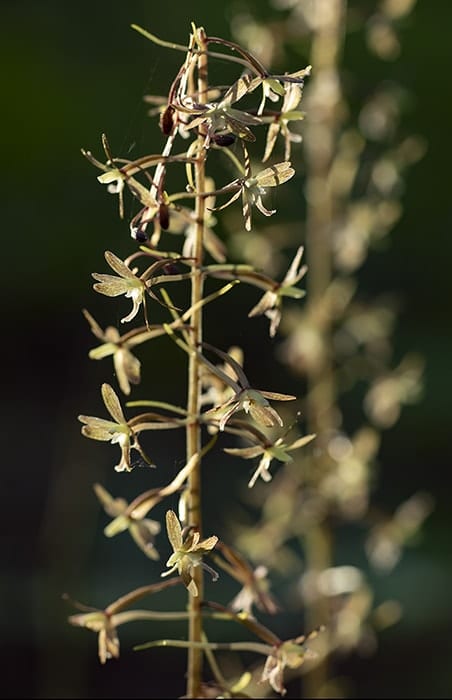
Beautiful Tipularia discolor.
Getting down and personal with the forest floor also allowed me an opportunity to observe the evolving plant life. Fleeting flowers that I could easily have missed, such as those of cranefly orchid and downy rattlesnake plantain, were discovered in pockets of stiltgrass. Later, I watched the cheery yellow of a woodland sunflower come into bloom and the green fruit of partridge-berry slowly develop into a vibrant candy-red. At some point the fronds of cut-leaf grape fern also made a magical appearance.
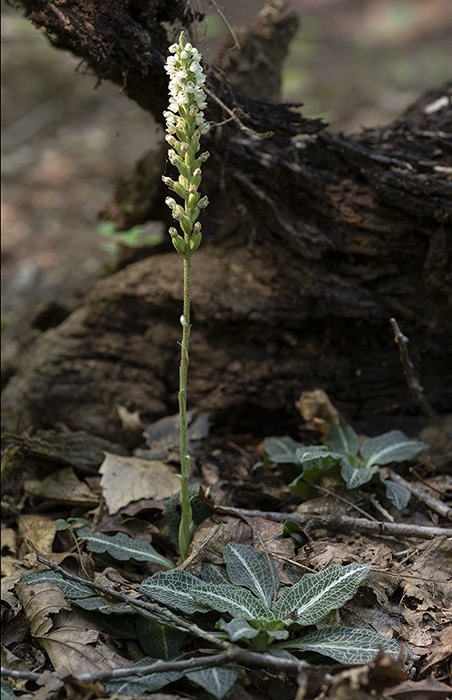
(Goodyera pubescens).
Since I considered this first year an experiment, I typically worked on my own, but not always. A few generous friends with probably more compassion than altruism gave up part of their days to work in tandem with me. The monthly restoration days I posted on the Fairfax County volunteer site and on MORE’s event calendar brought in more help and made the effort very productive.

He and his parents helped make a difference on an IMA work day.
Time well spent
At the end of the stiltgrass removal window, which for me was late September, I was ready for a break. In total, DC recorded a whopping sixty-two 90+ degree days and had experienced a “flash” drought to boot. The extreme weather was definitely one of my stressors.
But so much has been accomplished this first year in the park. The trail edges leading to and along Marc’s memorial are in better shape and one large section of hillside on the north-west side of his trail is now essentially—a word I use loosely here—invasive-free.
Alas, I’m aware that the ripened stiltgrass seeds, stubbornly viable in the soil for up to seven years, will sprout throughout the upcoming growing seasons. But I’m hopeful that there will be less of an infestation as time passes. Time will also reveal whether I’m truly indefatigable too.
This article was originally published in the Jan-Mar 2020 newsletter of Potowmack News, Potowmack Chapter of the Virginia Native Plant Society.
Invasive Management Resources:
Fairfax County, Virginia’s Invasive Management Area Program
Plant Invaders of Mid-Atlantic Natural Areas
There’s lots more information on the Invasive Plant Resources page.
